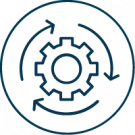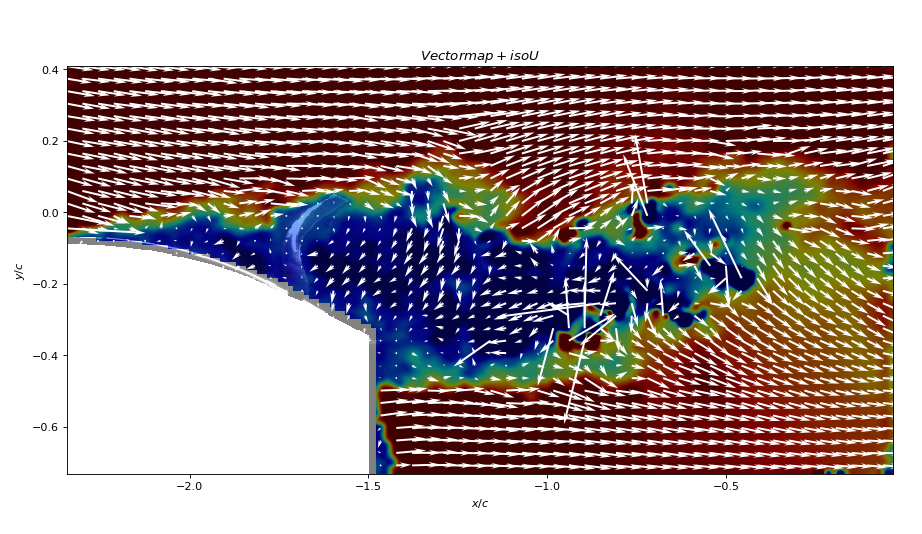
Background
Increasing the life of wind turbines is one of the major areas of investigation faced by wind farm operators. A cause of premature aging often put forward is the accumulation of loads imposed by the strong shears upstream of the rotor due to a malfunction of the wind turbine or the atmosphere in which it operates. In order to limit the influence of these disturbances on the wind turbine, one of the solutions envisaged today is what is called “retroffiting” or the integration of adjustment systems commonly known as “add-ons”. This involves modifying the aerodynamic surface of the blade a posteriori in order to improve its performances.
Scientific advances and innovation
Sensor and actuator add-ons for a dynamic adaptation of the blade aerodynamics.
The ASAPe project propose to develop a serie of original, robust and simple ADD-ON system, composed of E-penon sensors and/or wireless pressure sensors as well as fluidic actuators of pulsed jet type, capable of dynamically adapting wind turbine blade aerodynamic and thus to decrease aerodynamic loads. This system will be progressively brought to maturity by using a bidimensional blade profile in the aerodynamic wind tunnel of LHEEA lab. (gust at an intermediate scale) and the Jules Verne wind tunnel of CSTB (fluctuating wind at full scale). At full scale, a real wind turbine blade profile will be provided by industrials who have signed a support letter for the ASAPe projet (EDF-EN and VALOREM). Also, a prospectif work will be conducted to prepare wind field test (choice of the site, the wind turbine type, the position and control strategy …).
Expected technical and economic impact
The wind upstream of the wind turbine rotor is highly unsteady and inhomogeneous (misalignment of the rotor in the wind, turbulence of the atmosphere, gust … etc) while blade are increasingly longer. Using Add-ons (systems installed a posteriori) on the blade for a dynamic adaptation of the aerodynamics to prevent load fluctuations is foreseen to be a significant improvement to increase wind turbine lifetime.
Key project milestones
- May 2019 - Characterization of the LHEEA wind tunnel (intermediate scale) new perturbation system with its impact on airfoil load dynamics
- June 2019 - Sensors tested in the LHEEA wind tunnel and CSTB wind tunnel (full scale)
- January 2020 - Active control of blade aerodynamics in LHEEA wind tunnel with the new perturbation system.
- May 2020 - Actuator/sensor couples tests in LHEEA wind tunnel
- January 2021 - One chosen actuator/sensor couple tested in CSTB wind tunnel
- May 2022 - Add-ons for site tests
Demonstrator
The ASAPe project will be realized with the equipment acquired as part of the ROTOR-OPTIM project.
Demonstration of the control at intermediate scale (January 2020) and at full scale (January 2021).
Results
Characterization of flow behind chopper blade:
I. Neunaber, C. Braud, A. Soulier, S. Aubrun Wind Energy Science Conference, 2019, Cork, Irland.
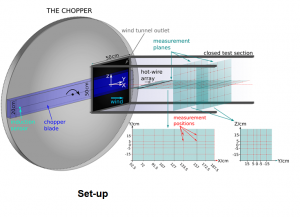
Main findings of the ASAPe project are gust scaling parameters:
- downstream position
- blade width
- rotational frequency
Ability eTellTale to detect flow features:
A. Soulier, C. Braud, D. Voisin, B. Podvin, et al Wind Energy Science Conference, 2019, Cork, Irland.
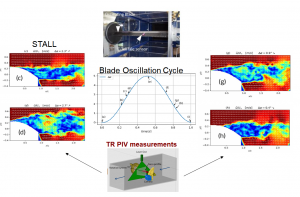
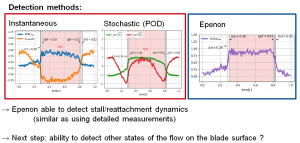
Wireless pressure sensors (CSTB)
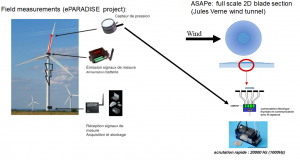
As a result of the ASAPe project, and based on its results, TWO new projects have emerged:
- Projet ePARADISE (Évaluation des Perturbations AéRodynamiques sur les pales pour l’Amélioration de la Durabilité et de l’Impact Sonore des Éoliennes)
- Projet MOMENTA
Publications and papers published
Publications
- I. Neunaber & C. Braud, First characterization of a new perturbation system for gust generation: the chopper , Wind Energ. Sci., 5, 759–773, 2020
- I. Neunaber & C. Braud Aerodynamic behavior of an airfoil under extreme wind conditions, Journal of Physics: Conference Series, Volume 1618-The Science of Making Torque from Wind (TORQUE 2020), 22 September 2020
- Soulier, A., Braud, C., Voisin, D., and Podvin, B.: Low-Reynolds-number investigations on the ability of the strip of e-TellTale sensor to detect the flow features over wind turbine blade section: flow stall and reattachment dynamics, Wind Energ. Sci., 6, 409–426, 2021.
- A. Soulier, C. Braud , D. Voisin, F. Danbon, High Reynolds wind tunnel tests for the evaluation of e-TellTale sensor to detect flow separation on wind turbine blades, Wind Energ. Sci., en préparation.
- I. Neunaber, E. Guilmineau, F. Danbon, P. Delpech, S. Courtine, D. Lenoir, A. Soulier, D. Voisin, C. Taymans, C. Braud, Observation of a natural spatio-temporal bi-stability on a full scale blade section at pre-stall angles of incidence, Short communication in Wind Energy, en préparation.
- I. Neunaber, A. Soulier, D. Voisin, F. Danbon, F. Delpech, D. Lenoir, C. Taymans, C. Braud, Testing aerodynamic sensors on a full-scale wind turbine blade, WES, en préparation.
- R. Mishra, I. Neunaber, E. Guilmineau, C. Braud, « Adapting turbulent inflows to bypass low Reynolds number effects on 2d blade sections » abstract submitted to the international conference TORQUE 2022.
Oral communications
- Soulier, C. Braud, D Voisin, F Dandon, V Jaunet, JJ Lasserre et P Galtier, Electronique Tell-Tale, a sensor to detect flow separation on wind turbine blades, SMARTEOLE colloquium, PRISME, Orléans, France, 2018
- Sandrine AUBRUN, Caroline BRAUD, Boris CONAN, Benyamin SCHLIFFKE (Centrale Nantes), Examples of wind-turbineoriented aerodynamic challenges, French American Innovation Day 2019, March 18-19 – Download the presentation
- Soulier, A., Braud, C., Voisin, D., and Podvin, B., Ability of the e-TellTale sensor to detect flow features over wind turbine blades: flow stall/reattachment dynamics, Wind Energ. Sci. Discuss., 2020
- A. Soulier, C. Braud , D. Voisin, F. Danbon, High Reynolds wind tunnel tests for the evaluation of e-TellTale sensor to detect flow separation on wind turbine blades, en préparation.
Organization of a mini-symposium during Wind Energy Science Conference, 2019 : “Active Flow Control on Blades”
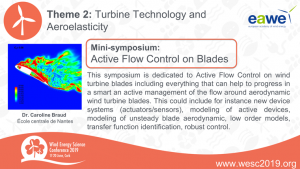
14 participants: Seimens-Gamesa, TUDelft, Forwind, DLR, DTU, ECN.TNO, Univ. Waterloo, IRPHE(FR), AIST (J), Scalian(FR), Mer Agitée(FR), LAAS(FR), LHEEA(FR), Orléans(FR)
Including 2 oral communications:
- Ingrid Neunaber, Caroline Braud, Antoine Soulier and Sandrine Aubrun (LHEEA – Ecole Centrale Nantes, CNRS), Characterization of a new perturbation system for gust generation: The Chopper, Wind Energy Science Conference, 2019, Cork, Irland. 18 juin 2019
- A. Soulier, C. Braud, D. Voisin, B. Podvin, et al, Ability eTellTale to detect flow features. Wind Energy Science Conference, Cork, Irland 2019
Organization of a minisymposium on “Smart Blade technologies” with IWES, FORWIND, AIST, TU-Delft and DLR at the international conference WESC 2021: ~10 participants from international laboratories (IWES, TU-Delft, DLR, ForWind, AIST etc …)
Including 3 oral communications:
- C. Braud, I. Neunaber, F. Danbon, P. Delpech, D. Lenoir, E. Mornet, Y. Queveau, A. Soulier, D. Voisin, C. Taymans “Wind tunnel full scale aerodynamic sensors assessment prior to field tests” Wind Energy Science Conference, On-line to due COVID-19, organisation: Forwind – Hannover, May 2021.
- A. Soulier, D. Voisin, I. Neunaber, F. Danbon, P. Delpech, E. Mornet, Y. Queveau, C. Braud “Flow separation detection performance of the e-Telltale evaluation at full scale” Wind Energy Science Conference, On-line to due COVID-19, organisation: Forwind – Hannover, May 2021.
- I. Neunaber, E. Guilmineau, F. Danbon, P. Delpech, A. Soulier, D. Voisin, C. Taymans, C. Braud “High Reynolds number blade aerodynamics: 3D flow separation dynamics” Wind Energy Science Conference, On-line to due COVID-19, organisation: Forwind – Hannover, May 2021.
Prospects
Validation of Add-ons on a real wind turbine or back to wind tunnel tests for improvement of add-ons or developments of new actuator/sensor technologies.
